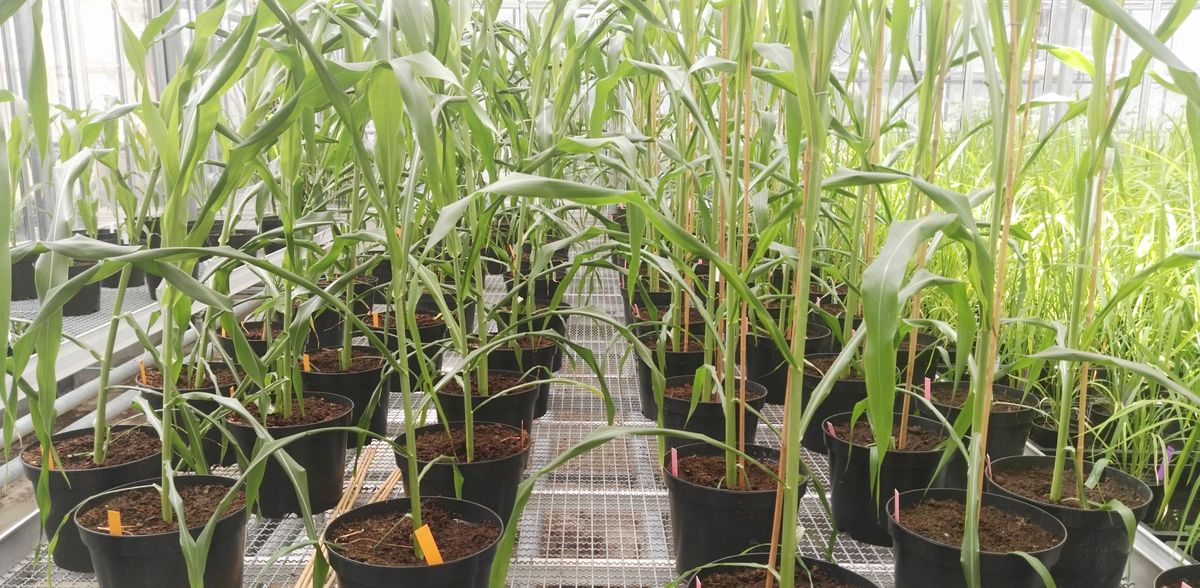Crops: Gene switch makes sweet sorghum salt-tolerant
KIT researchers clarify sugar accumulation in sorghum millet under salty conditions: SWEET13 gene directs sucrose into the grains
Sorghum is regarded as the crop of the future: it builds up a particularly large amount of biomass and thrives even under harsh conditions. Certain varieties even produce more sugar on salty soils. As part of an international team, researchers from the Karlsruhe Institute of Technology (KIT) have now investigated this salt stress-induced sugar accumulation in more detail and discovered that the SWEET13 gene switch directs the sugar into the grains. SWEET13 can be bred into different varieties of sorghum in order to contribute to food security.

Ears of two different varieties of sweet sorghum after cultivation under salt stress. Top: "Della" variety, which shifts fewer resources into the seeds due to a less active variant of the SWEET13 gene. Bottom: Syrian landrace variety "Razinieh", which has a salt-activated SWEET13 allele and therefore stores more carbohydrates in the seeds.
KIT
The growth of the world's population and the associated increase in demand for food, raw materials and energy means that the productivity of plants, especially cereals, must increase significantly. However, the effects of climate change are making this increasingly difficult. In addition to heat and drought, the salt content of the soil is also putting plants under stress. This is because rising sea levels are causing more and more fertile soils to become saline. One solution could be cultivated plants that build up a particularly large amount of biomass and also thrive on salty soils.
The Molecular Cell Biology working group headed by Professor Peter Nick at the Joseph Gottlieb Kölreuter Institute of Plant Sciences (JKIP) at KIT has been studying sorghum millet, a type of millet from the sorghum genus in the sweet grass family, for several years. The sugar-rich varieties are known as sweet sorghum. Sorghum is one of the plants that photosynthesize particularly efficiently and therefore bind carbon dioxide (CO2) better and build up more biomass than other plants. In earlier research work, the Syrian scientist Dr. Adnan Kanbar at KIT developed a new type of sorghum that accumulates a particularly large amount of sugar and can be used to produce biogas and biofuels as well as new polymers.
Certain varieties produce more sugar under salty conditions
Further research shows that sorghum, an ancient crop from Sudan, also thrives in harsh conditions. "Certain sorghum varieties not only cope well with salt, but even produce more sugar under salty conditions," says Nick. "Some of these varieties store the sugar in the stalk, which makes them interesting for energy use, i.e. for the production of biofuels. Others store the sugar in the seeds so that they can contribute to human nutrition."
SWEET13 gene switch directs sucrose into the grains
A group of researchers led by Dr. Eman Abuslima from Egypt, who completed her doctorate in the Molecular Cell Biology working group at the JKIP of the KIT, investigated this sugar accumulation caused by salt stress and the different sugar storage in sorghum. They discovered that the SWEET13 gene is responsible for sugar transport. "SWEET13 works like a switch that ensures that the sucrose produced by photosynthesis is directed into the plant's grains," explains Abuslima. The researchers found a particularly active version of SWEET13 in the old Syrian sorghum variety Razinieh. This gene switch can be crossed into other varieties through breeding. A polymerase chain reaction (PCR) helps to identify the offspring with the correct variant at the seedling stage. "This molecular knowledge can help to secure human nutrition in areas affected by soil salinization," says Peter Nick. The Nile Delta, Bangladesh, Vietnam and the south of Italy are already struggling with the problem of salt stress.
Note: This article has been translated using a computer system without human intervention. LUMITOS offers these automatic translations to present a wider range of current news. Since this article has been translated with automatic translation, it is possible that it contains errors in vocabulary, syntax or grammar. The original article in German can be found here.





























































